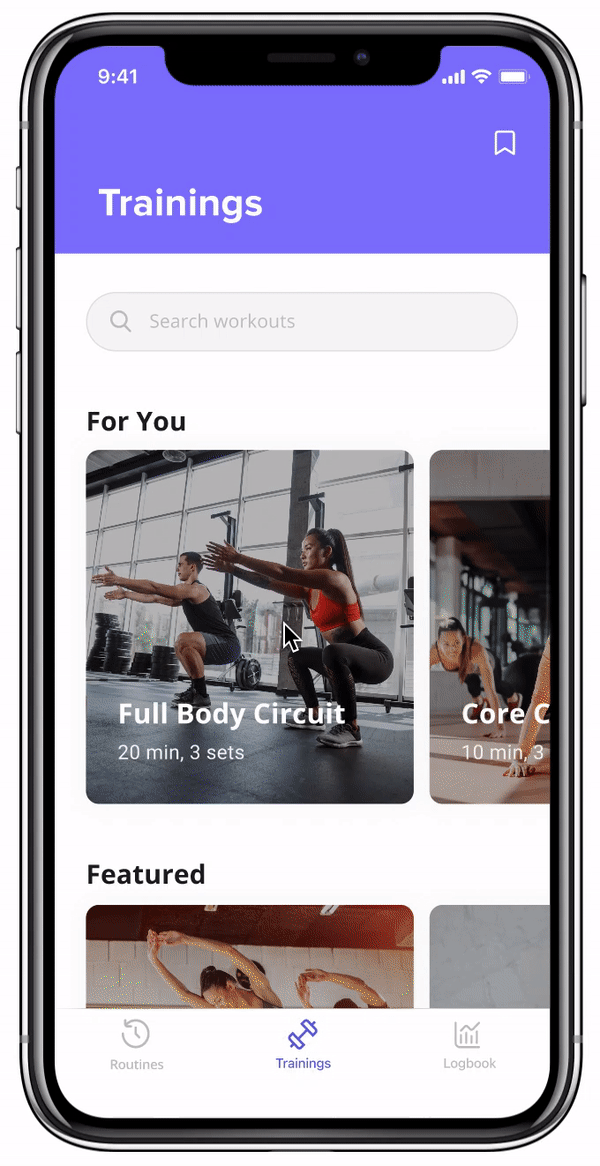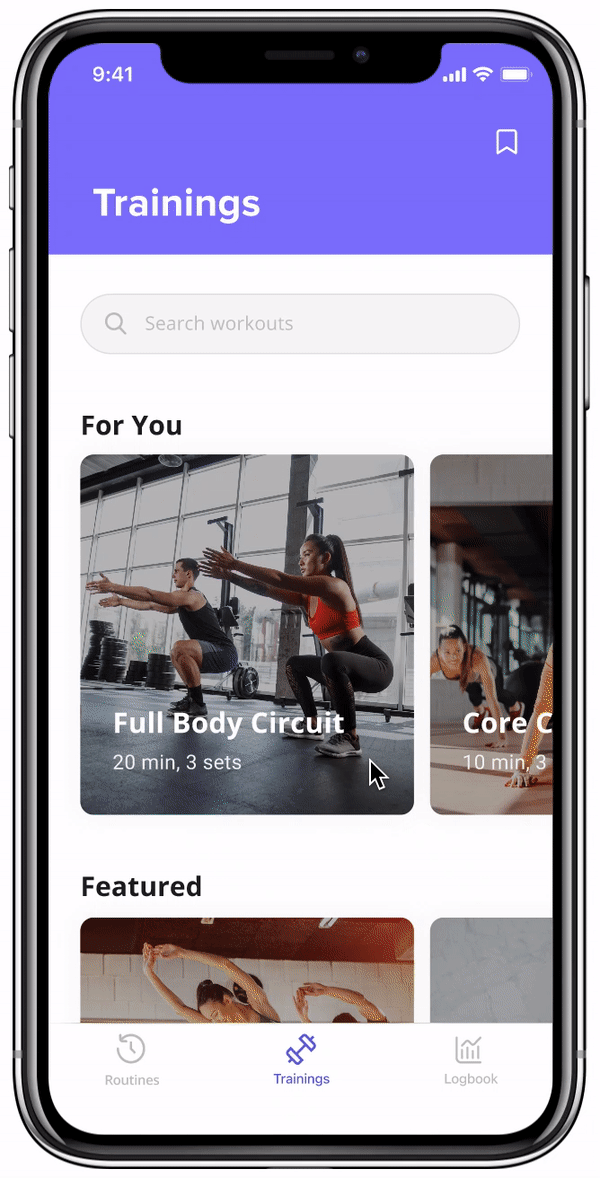
Pacer
Build workout routines at your own pace.
About Project
A workout routine app that helps users build their own workout routines and track workout progress.
One of my clients came up with an idea of a workout routine app that can build own workout routines and track workout activities. He loves exercising on a daily basis and makes plans before he starts workouts. Since many workout apps were made for beginners, it is easy to start programs with one click but is not fully customizable for intermediate or advanced level users who have their own routines and plans. With this idea, I wanted to create an app that will help build a workout routine for all fitness users.
My Role
User Research, UI/UX Design, Wireframe, Prototyping
Duration
12 weeks
Tool Used
Figma, Adobe Photoshop, Adobe Illustrator

Problem
The users struggle to build the workout routines related to their fitness levels and keep track on their workout progress.
Solution
Pacer: A workout routine app that helps users find workouts, build a routine, and track workout progress.
Start your workout with your own plan and timer
If users want to start working out without a complicated process, they can simply select a template and start a workout timer. It is also fully customizable for users who want to do more than one activity.
Build your routines with workout scheduling
The users can find a training program as they need, start working out or schedule it into their routine. Once they have scheduled it, it will show on their routine page like other workout plans.

Design Progress
How did I actually get there?
In my first sprint, I focused more on designing a workout timer like other competitors did. After my user research, I transitioned my focus to building a workout routine with an app based on the user's needs and pain points.
Research Plan
Defining research objectives
Before I deep dive into the problem, I wanted to understand the user’s motivations, experiences, and behaviors when they do workouts. First, I analyzed competitors to understand how they provide services to users and discover design opportunities for our product. After that, I conducted user interviews with people who love doing workouts and have experience in a workout app. My goals included the following:
Understand how people currently track time when it comes to workouts
Discover workout apps that people often use and the motivations
Understand user’s experiences and frustrations

Competitive Analysis
The competitors focused on a workout timer or routine itself
In my first assumption, a workout timer app that is able to set a different timer for each workout would be a good product for people who love workouts with their plans. So I analyzed two groups of competitors, one is the direct competitors that are focused on a workout timer and the indirect competitors that are focused on building a routine. All competitors provide a workout timer that helps users track their time during workouts but it has limited to building their workout plan.
User Research
Understand users and their needs
Conducting 5 interviews with individuals of different fitness levels, including both frequent and infrequent exercisers, allowed me to gain a comprehensive understanding of their diverse experiences and requirements. By synthesizing the collected data, I was able to uncover valuable insights, revealing three key pain points commonly faced by individuals in their fitness journeys.
😅
Have no idea what to start for my workout
⇣
Fitness Level: Beginner
Fitness beginners are not sure what they need to do at first, so they prefer to get recommendations and training videos.
🤨
Wasn’t able to customize a workout plan
⇣
Fitness Level: Advanced
People want to repeat their workout as a routine but many products are not allowed to customize a plan or schedule time as they need.
😔
Difficult to track on my workout progress
⇣
Fitness Level: All Levels
Many people struggle to remember what they need to do next so if they can track their progress, it will help people keep their plan to achieve a goal.
Affinity Map
Empathy Map

Defining the user
Meet Elina, a 31 year old software engineer from New York
With my insights from the interviews, I created a persona that can help me stay focused on the user’s motivations, goals, and frustrations. Elina is a software engineer who is working from home and love doing workouts as her own plans. She wants to build a workout routine to keep her shape but she confuses about what and how to start.
Defining the problem
How could I translate these pain points into design opportunities?
By utilizing the HMW statement approach, I transformed problems into opportunities, fostering a mindset of creative thinking and ideation. This enabled me to explore diverse possibilities and generate innovative solutions for the challenge at hand.
😅
Have no idea what to start for my workout
⇣
How might we provide training programs based on their fitness level?
🤨
Wasn’t able to customize a workout plan
⇣
How might we enable users to customize their workout plans according to their needs?
😔
Difficult to track on my workout progress
⇣
How might we simplify the process of tracking workout progress?

Ideating the solution
Generate ideas with Crazy 8s
To brainstorm my ideas, I run quick sketches for the main features of the app. The four main features included: Add new routine, Routine timer, Training videos, and Logbook. This exercise helped me think of various solutions for the app and keep me focused on the main goal - building a workout routine.
Validating ideas and getting feedback
Low-fidelity wireframes
I tested my low-fidelity wireframe with users to see if there were any frustrations with the interactions and flows. My main concern was the routine page because this is the page that included the main task and the user should be able to understand how to use the feature at first. This is what I learned from early testing:
Users liked seeing the idea of daily and weekly routines
Users get confused with a dropdown interaction when open and close a workout
Need more intuitive icons for main tasks (i.e. add to routine)

UI designs
Pacer: Working out at your own pace
The name “Pacer” describes the people who want to build a workout routine at their own pace. The logo design is made up of P from the name of the app and the image of a routine timer. I chose the purple color as a primary color to give a feel healthy, energetic and calming.
UI Kit

Solution #1
How might we make training programs could be saved as a routine?
Find workouts and add them to my routine
The users can find a training program according to their needs and add it to their routine page. So it will show on the selected dates and users can keep focused on their workouts as they need.

Solution #2
How might we offer a customizable plan for users to build their own routine?
Create your own routine using a template
If users want to create their own routine, they can simply choose a template and change the settings. The custom option is good for people who want to do more than one activity.
Quickstart workout with a preset timer
The app provides a preset timer so users can start a workout without a complicated process. They can simply click the start button and use a timer during the workouts.

Solution #3
How might we make a logbook for users to tracking progress?
Track my workout progress and activities
The app provides the workout progress in graphs and numbers. It will help users to motivate themselves to achieve a goal.

Usability test and iterate
Usability Testing with hi-fi prototype
I conducted usability testing with 16 participants through Maze and 4 participants in person. I interviewed some of the participants while testing the prototypes. The test results from Maze showed the screens that users had struggled with the most when they completed the tasks. From the usability interview, I could hear more details about their pain points and how they feel about the app. This is what I found from the usability testing:
All UI designs (e.g. buttons and icons) should be more clear and intuitive
Users always want to have a simple process and to be done in fewer steps
Give direct access to the major features, do not let users find out about it
Final Design
Adding a new routine and starting workout
Saving training videos to build your own routine

Reflection
Reflection and next steps
This project was a challenge in a good way. I have not used many fitness apps before so I had to research the workout types and what informations need to know while working out. I learned and got ideas from my friends who love workout and one of the clients. It was not easy starting a new project without experience but I learned a lot about how to design a product from the beginning.
Along with my client, we are planning to make an actual routine app similar to my case study but more focused on planning a routine. For the efficient approach, I will define the product MVPs and change the design in the discussion. Our goal is to launch the app as soon as possible and get early feedback from the users based on their experiences. It will be another challenge but an interesting project.
More Projects:
Citi Bike
Bike Share • Add a feature • UI/UX Design
Easy way to find your rides and stations.
Dev Launchers
Tech Community • Design System • UX/Product Design





















